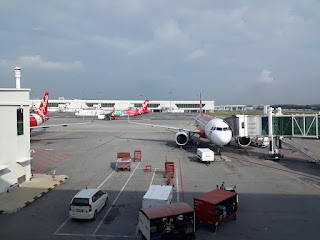AirAsia: Kuala Lumpur to Singapore by *brand new* Airbus A321neo
AirAsia received its first Airbus A321neo aircraft on November 2019, with 352 more to be delivered over the next few years. The A321neo is a re-engined and enhanced version of the A321 that offers better fuel efficiency, range, and carrying capacity, and have the potential to alter the dynamics of the regional budget airline industry.
I managed to secure a one-way ticket from Kuala Lumpur to Singapore on board AirAsia's first Airbus A321neo, 9M-VAA.
Introduction: Airbus A321neo
The Airbus A321neo is an evolution of the original A321 featuring a pair of new engines that offered better fuel efficiency as well as refinements found on the A320 Enhanced (sharklets, aerodynamic refinements, and weight-saving features).
In 2012, AirAsia placed an order for 100 Airbus A321neo aircraft, later increased to a total of 353 in early 2019 after the airline "upsized" its outstanding order of 253 A320neos to A321neos. When all of these aircraft are delivered in 2028, AirAsia will operate the world's second largest fleet of A321neo aircraft, behind IndiGo which has 398 aircraft on order.
AK707: Kuala Lumpur to Singapore flight experience (A321neo)
I arrived at KLIA2 by airport bus from KL Sentral.
Entering KLIA2's main terminal building.
As I do not have any checked baggage with me, it is just a simple matter of checking in at one of the many self check-in kiosks scattered around the terminal.
Entering the International Departure Hall. Most of the flights at this time were domestic and regional flights within Southeast Asia.
International flights use either L-, P-, or Q-prefixed gates. P and Q gates are located at the satellite terminal building, accessible via the iconic Skybridge.
Walking along the Skybridge.
The Skybridge provides a good view of the contact pier (J, K, and L gates) and the satellite terminal's narrow-body gates.
At the end of the skybridge is a large duty-free shopping gallery and several dining outlets.
Security screening is conducted after the entrance to the P-gate pier.
The flight's assigned gate (P17) was located towards the end of the pier.
Here comes the aircraft. 9M-VAA is the first A321neo to be delivered to AirAsia, and to commemorate this occasion, the aircraft received a special, one-off "3, 2, 1, take off" livery.
Boarding calls were made soon after all passengers had disembarked.
One notable exterior feature of the A321neo was the black "mask" around the cockpit windows. AirAsia's A321neos will feature this black "mask".
Note the longer fuselage of the aircraft.
Interior of 9M-VAA. The A321neo is configured to carry 236 passengers in 41 rows of seats.
The A321neo is fitted with Mirus Hawk slimline seats that feature innovative, weight-saving features that are essential to the A321neo's higher passenger capacity.
All seats are fitted with a single USB port.
The tray table comes with a gadget stand for your smartphones or tablets.
View of the safety information card.
The most important innovation of A321neo lies within its new CFM International LEAP-1A engines. These engines incorporate new design features and composite materials that made them 15% more fuel efficient than the current CFM 56 engines.
Taxiing under the Skybridge.
Taking off from Runway 33.
Climbing to cruising altitude of 27,000 ft.
View of the A321neo's aft lavatories. The aft lavatories in the A321neo are relocated to the aft bulkhead to allow an additional row of seats (row 41) to be fitted. One of the crew seats are integrated into one of the lavatories' door to save more space.
Relocating the lavatories allowed for a larger aft galley, which occupied the space freed up by one of the relocated lavatories.
Due to the additional passenger capacity, two inflatable life rafts were required. These are stored in special overhead compartments located towards the aft of the aircraft.
View of the A321neo's Type C door ("Door 3"). Customer airlines may opt for this pair of doors to be disabled or "plugged" if they do not require such a high seating capacity. When this pair of doors is disabled, the A321neo's maximum passenger capacity is reduced from 240 to 195.
In certain cases where an even lower seating capacity is desired, a pair of overwing exits can be disabled. Once disabled (along with door 3 disabled), the A321neo's capacity is further reduced to 165.
Less than 25 minutes after departure from KLIA, 9M-VAA began its descent to Changi Airport near Karimun, Indonesia.
Flying over Batam on approach to Changi Airport.
Touched down at Runway 02L, Changi Airport
AirAsia is the largest airline that operates out of Changi Airport's new Terminal 4.
Arrived in Singapore less than an hour after departing from KLIA.







































Comments
Post a Comment